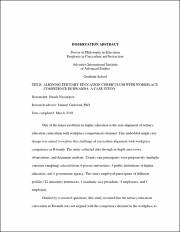Aligning tertiary education curriculum with workplace competence in Rwanda : a case study
Abstract
One of the major problems in higher education is the non-alignment of tertiary
education curriculum with workplace competencies demand. This embedded single case
design was aimed to explore this challenge of curriculum alignment with workplace
competence in Rwanda. The study collected data through in-depth interviews,
observations, and document analysis. Twenty-one participants were purposively (multiple
variation sampling) selected from 4 private universities, 4 public institutions of higher
education, and 1 government agency. This study employed participants of different
profiles (12 university instructors, 4 academic vice presidents, 4 employees, and 1
employer).
Guided by 4 research questions, this study revealed that the tertiary education
curriculum in Rwanda was not aligned with the competence demand in the workplace as
the content, programs (fields of study), and instructional methods being used do not
adequately address the local workplace needs. With regard to the employability
competencies most needed, the study found that generic skills were needed at 42.66%
against 57.33% of specific competencies. Moreover, among generic skills, the study
found that communication skill was to be the highly preferred by employers.
Furthermore, the study found the engagement of university-external stakeholders in
curriculum activities was very limited and hence recommended the tripartite
partnership—university-government-industry.
Similar to previous studies that assert that labor market information is a
contributing factor to educational supply and workplace demand alignment, this study
found that there is enough information that could serve to inform both education and
business decisions. However, participants indicated that the information is mismanaged
and spread out to the extent it is not informative. Thereby, the participants suggested the
establishment of labor market information system. The study ended with a curriculumworkplace
alignment model based on 6 dimensions which will further guide the extension
of this study through quantitative perspectives.


